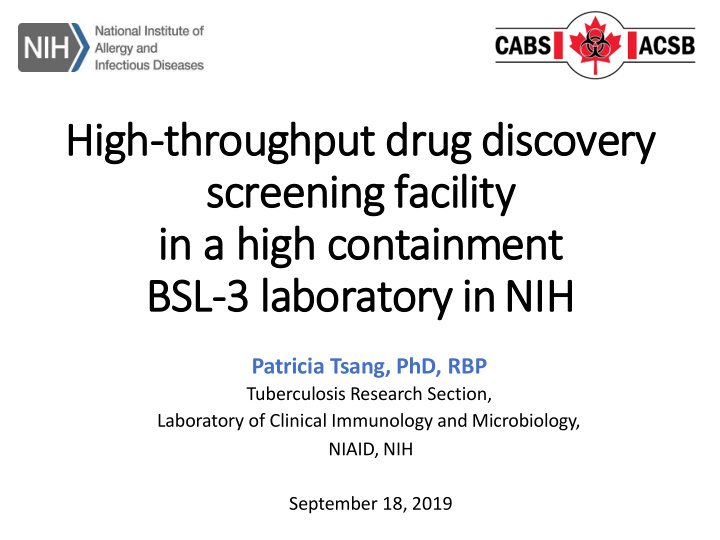



Hi High-throughput drug di disco cove very y scree eening facility in a a high gh con onta tain inment t BS BSL-3 lab aborator ory y in inNI NIH Patricia Tsang, PhD, RBP Tuberculosis Research Section, Laboratory of Clinical Immunology and Microbiology, NIAID, NIH September 18, 2019
Objec ectives es 1. Implementation of the NIH Biosafety Program 2. High-throughput drug discovery screeningfacility in the Building of Biodefense (Bldg. 33) 3. Drug discovery efforts in Tuberculosis Research Section, NIH • Mycobacterium tuberculosis • Middle east respiratorysyndrome coronavirus (MERS-CoV) • Candida auris (multi-drug resistant strains)
Background of a ‘Sure rety’ Pr Progra ram
Impl plement ntation n of the Biosafe fety ty Progra Pr ram : Step 1 1 Pathogen registrations • Risk assessment • BSL and PPE determination • IBC approval • E-sign off by researchers • Web interface that manages: o Protocols o Researchers o Lab surveys
Implem ementati tion on o of the Biosafety Prog ogram Risk assessment and risk management • Follow safe work practices (BMBL) • Draft lab specific biosafety manuals • Write lab specific SOPs
The Gold Standard for Biosafety in USA 1984 2007 Both a code of practice and an authoritative reference “guidance document”
Implementat ation o of the Biosafety ty Prog ogram Background investigations Safety trainings • Lab biosafety / Bloodborne pathogens • Agent Specific Training • Incident and spill procedures • BSL-3 hands-on training Evaluations • Occupational Health • Behavioral Health
Ag Agent nt Speci cifi fic c Training: Objec ective ves BSL-3 user Visitor training training requirements requirements Agent Entry and Exit specific procedures information Working in the BSL-3 lab / lab specific SOPs/ inactivation protocols Emergency Security Incident and Spill procedures procedures procedures
Per ersonal l pr protection equipment (PPE) E) Head cover Head Eye Eye protection goggles N95 (Annual fit test) Respiratory system PAPR (Monthly validation) Body Coverall suit w ith integrated booties Double gloves Hand Foot Shoe covers
Impl plement ntation n of the Biosafe fety ty Pr Progra ram : Agent nt accoun untabi bility Limited access Inventory management • Location records • Traceable records • Transfer records
Elect ctro ronic i c inventory ma manag agem ement sys ystem em Re Real-tim ime eq e equipment monitoring s system
Implementat ation o of the Biosafety ty Prog ogram: Biosec ecurity ty Facility access • Authorized access • Dual-authentication system Facility security • Internal monitoring • External monitoring • Lab inspections and spot checks
The C.W. Bill Young Center for Biodefense and Emerging Infectious Diseases (Bldg 33) http://www.whiting-turner.com/portfolio/industry/federal/9770/9770.html https://nihrecord.nih.gov/newsletters/10_14_2003/story01.htm
The C.W. Bill Young Center for Biodefense and Emerging Infectious Diseases (Bldg 33) m Mechanical PH Maintenance i Labs 3 i 2 Labs i 1 Labs m B Labs/Vivarium http://www.thebellcompany.com/projects/11/building-33-national-institues-of-health/
High-Throughput drug discovery screening facility BioPROTECT walk-in and reach-in equipment containment safety enclosure (Class II, Type A2), 164-cubic foot
High-Throughput drug discovery screening facility Biomek Fx liquid handler Viaflo 96 liquid dispenser EnVision microplate reader
High-Throughput drug discovery screening facility Fully automated HTS system
Hi High gh-thr hroug ughput hput drug ug discover very efforts in TRS, TRS, NI NIH • Whole-cell screening approach • Determination of compound activity against live cells • All physiologically available targets explored at once • A true hit always exhibits antibacterial activity • Quick and dirty • Target has to be identified • Main pathogen of interest: Mycobacterium tuberculosis • Other emerging pathogens that require BSL-2+/3 labs
Mycoba bacterium um t tuberculosis Tuberculosis Research Section (TRS), NIH
Collaborative efforts in accelerating drug discovery for Tuberculosis What is the TB Drug Accelerator? The TBDA is a groundbreaking partnership between eight pharmaceutical companies, eight research institutions, and a product development partnership that seeks to develop a new TB drug regimen through collaboration in early-stage drug discoveryresearch. With Participation From: 21
Middle east respiratorysyndrome coron onavirus (ME MERS-CoV oV) • Middle ddle Ea East r respirat atory syndrome (MERS) is is a a vi viral r res espiratory disea ease e caused ed b by a a no novel l coronavirus ( Middle Ea East r respiratory y syndro rome c coro ronaviru rus , or MERS RS-CoV) V) that wa was first ide dentif ifie ied i in n Saud udi i Arabia bia in 2012 2012 • Coronavi viruses es are a a large ge family of of viruses es tha hat c can n cause d e disea eases es ranging from the he co common on co cold to Sev ever ere e Acute Res espiratory Syndr ndrome (SARS) • Appr pproxim ximately 35% 35% of reported ed p patients with h MERS RS hav ave di died http://www.who.int/en/news-room/fact-sheets/detail/middle-east-respiratory-syndrome-coronavirus-(mers-cov)
Reported cases as of August, 2018 Reported cases as of July, 2019 https://www.cdc.gov/fungal/candida-auris/index.html
not m mentio ioned
A s succe ccessf ssful biosaf afety y program • Communications • Recordkeeping • Operations • Planning • Inspections DOHS, NIH Responsible Officer (RO) Investigator (PI) Lab Manager Individual
Conc nclus usions ns 1. Implementation of NIH’s Biosafety Program in the lab – involves every stakeholder in the lab, from the PI, researchers, lab manager, IBC committee to approve pathogen registrations, biosafety officers to conduct lab inspections, IT infrastructure to manage inventory and equipment 2. High-throughput drug discovery screeningfacility in the Building of Biodefense 3. Decide the most appropriate BSLs per recommendation of your institute’s safety committee, based on risk assessment and risk group analysis of the pathogens, especially the multi-drug resistant strains
Ac Acknow owled edgem ement Funding Tuberculosis Research Section, LCIM, NIAID,NIH Dr Clifton Barry Dr Helena Boshoff HTS screen team Division of Occupational Health and Safety, NIH
Recommend
More recommend